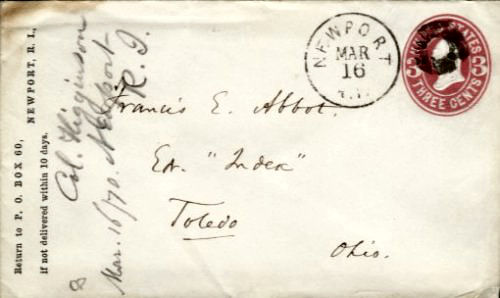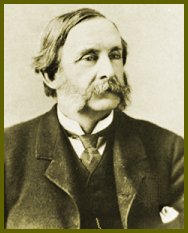![]()
Postal History Introduction
Stampless
Covers
1846
to 1900 Issues
1901-1950
Issues
1951-2003
Issues
Cancels
&
Miscellaneous
Postal
Stationery
Post
Cards
Air
Mail
First
Day &
Event Covers
Parcel Post/Special Delivery
Registered & Official Mail
Commercial & Advertising
Revenue & Postage Due
Wildlife & Game Issues
Complete List of RI Issues
|
Rhode Island Stamp Issues & Covers
1846 to 1900 |
||
|
||
|
Colonel
Thomas Higginson
Courtesy Library of Congress
|
This item is the cover only of a letter that Thomas Higginson sent from Newport, Rhode Island on March 16, 1870 to Francis Abbot in Toledo, Ohio. Thomas Wentworth Storrow Higginson was born on December 22, 1824 in Cambridge, Massachusetts. He was a noted American reformer and abolitionist. He commanded the 1st South Carolina Volunteers during the Civil War; the first Black Regiment in the U. S. Army. Thomas received a Degree in Arts from Harvard University in 1841 and graduated from Harvard Divinity School in 1847. After being ordained in 1847; he became the pastor of the First Religious Society Church (Unitarian) in Newburyport, Massachusetts, where he met and married his first wife, Mary Channing. The Reverend Higginson was a bit too liberal even for Unitarians and after two years; his progressive views on Slavery, Women's Rights and Labor caused him the loss of his position. |
|
|
In 1850, after the passage of the Fugitive Slave Act, Reverend Higginson joined the Boston Vigilance Committee to Aid Escaping Slaves. He also was a strong supporter of John Brown and Kansas Free State Movement, (1852). Reverend Higginson was the pastor of the Free Church in Worcester, Massachusetts from 1852 to 1861. He also played a leading role in freeing the fugitive slave, Anthony Burns in 1854. Thomas Higginson was appointed a Colonel in the United States Army during the Civil War and in 1862, he was given command of the 1st South Carolina Volunteers, the First Black Regiment in the U. S. Army. The 1st South Carolina Volunteers was organized in May 1862 under General David Hunter and the troops consisted mostly of freed slaves from the Hilton Head Island area of South Carolina. Colonel Higginson assumed command of the 1st Carolina on November 10, 1862. The regiment fought their first battle under Higginson in January 1863 at Township Landing on the Saint Mary's River along the Florida-Georgia state line. The 1st Carolina won the battle with the loss of 1 killed and 7 wounded. In March of that year the 1st and 2nd Carolina Regiments occupied Jacksonville, Florida where they repulsed several Confederate attempts to retake the town. The 1st Carolina was redesignated as the 33rd United States Colored Troops on February 8, 1864 and combined with two other regiments one of which was the 54th Massachusetts, (Glory). On July 2, 1864 they took part in the assault on Battery Gregg at James Island, South Carolina, (Just south of Charleston) and in December they fought in the Battle of Honey Hill along with the 55th Massachusetts. During their final year in service, the 1st Carolina served on Garrison Duty in Savannah and Charleston. They were mustered out on February 9, 1866 at Fort Wagner in Charleston, SC. Colonel Higginson was wounded in South Carolina in 1863 and mustered out in 1864. After leaving the service, Thomas and his wife Mary, (who was in ill health) relocated to Newport, Rhode Island. It was during this period (1864 to 1879) that he sent the letter shown above. Thomas was a prolific writer and wrote over 500 articles and 30 books; he was a frequent contributor to the Atlantic Monthly. Thomas fell in love with Newport and he became deeply involved in the community. He was chairman of the School Committee and led the movement to abolish Separate Schools for Black and White children in 1865. During his Newport period, he wrote his first novel, "Malbone; An Oldport Romance." He was a director of the Redwood Library and a member of the Town and Country Club. After the death of his first wife, Mary; he moved back to Cambridge and married his second wife, Mary P. Thatcher. Thomas discovered and encouraged the poet Emily Dickinson. He maintained an extensive correspondence with both Emily Dickinson and Walt Whitman. Thomas Higginson died on May 9, 1911 in Cambridge, Massachusetts. Sources: |
||
![]()
RI Historical
Society
The Post Offices
Home Page
RI Tercentenary Issue History
RI Philatelic Society
Recently Added Pages
Philatelic Primer
Rhode Island Around the World
Rhode Island
Town Postmarks
Other Websites of Interest

